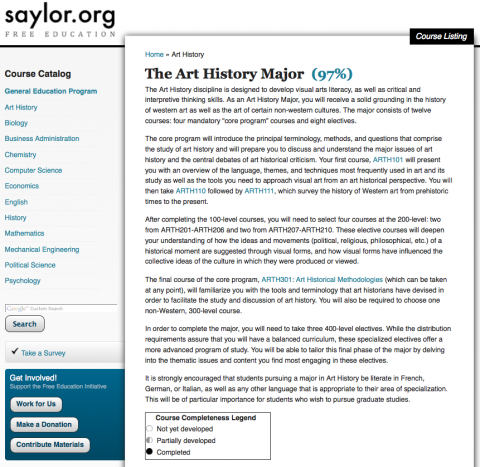The Art History (for full free course click here) discipline is designed to develop visual arts literacy, as well as critical and interpretive thinking skills. As an Art History Major, you will receive a solid grounding in the history of western art as well as the art of certain non-western cultures. The major consists of twelve courses: four mandatory “core program” courses and eight electives.
The core program will introduce the principal terminology, methods, and questions that comprise the study of art history and will prepare you to discuss and understand the major issues of art history and the central debates of art historical criticism. Your first course, ARTH101 will present you with an overview of the language, themes, and techniques most frequently used in art and its study as well as the tools you need to approach visual art from an art historical perspective. You will then take ARTH110 followed by ARTH111, which survey the history of Western art from prehistoric times to the present.
After completing the 100-level courses, you will need to select four courses at the 200-level: two from ARTH201-ARTH206 and two from ARTH207-ARTH210. These elective courses will deepen your understanding of how the ideas and movements (political, religious, philosophical, etc.) of a historical moment are suggested through visual forms, and how visual forms have influenced the collective ideas of the culture in which they were produced or viewed.
The final course of the core program, ARTH301: Art Historical Methodologies (which can be taken at any point), will familiarize you with the tools and terminology that art historians have devised in order to facilitate the study and discussion of art history. You will also be required to choose one non-Western, 300-level course.
In order to complete the major, you will need to take three 400-level electives. While the distribution requirements assure that you will have a balanced curriculum, these specialized electives offer a more advanced program of study. You will be able to tailor this final phase of the major by delving into the thematic issues and content you find most engaging in these electives.
It is strongly encouraged that students pursuing a major in Art History be literate in French, German, or Italian, as well as any other language that is appropriate to their area of specialization. This will be of particular importance for students who wish to pursue graduate studies.
Text from - http://www.saylor.org/majors/art-history/
Salyor.org has been nominated for various #OCW People’s Choice awards for Most innovative and avant garde please Vote here.




